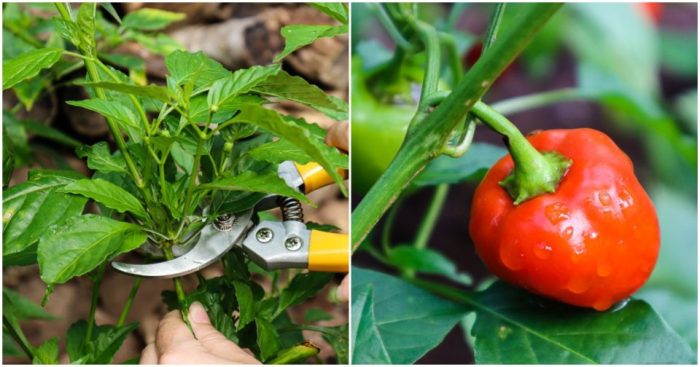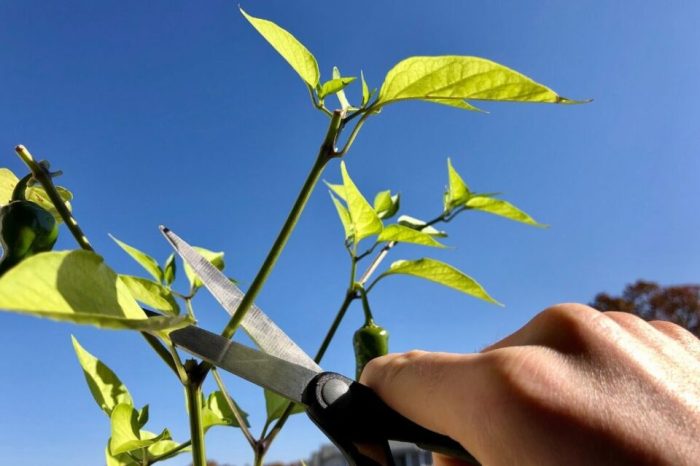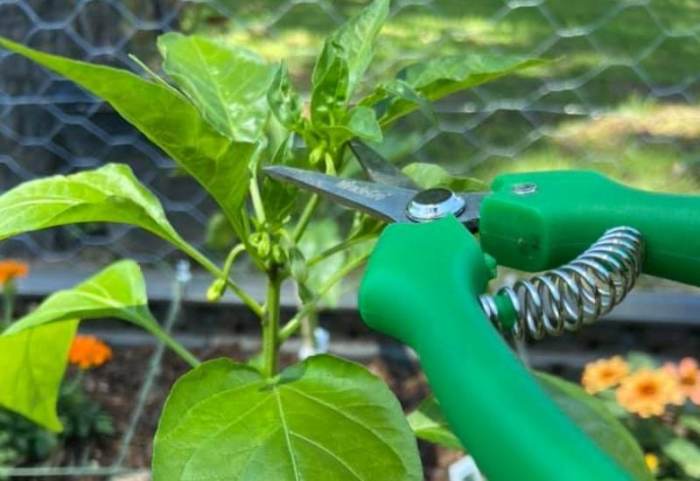How to prune pepper plants in pots – Master the art of pruning pepper plants in pots to maximize their health, productivity, and fruit production. This comprehensive guide delves into the various pruning methods, benefits, timing, and specific varieties, empowering you to cultivate thriving pepper plants that will delight your taste buds.
Unlock the secrets of successful pruning techniques and discover how to enhance air circulation, promote fruit development, and safeguard your plants from diseases. With expert guidance and practical tips, you’ll learn the optimal timing for pruning and establish a regular schedule to maintain plant vigor and yield.
Pruning Methods

Pruning pepper plants in pots helps promote plant health, increase yields, and improve fruit quality. Various pruning methods can be employed, including pinching, topping, and suckering.
Pinching
Pinching involves removing the growing tip of a plant to encourage lateral branching. This promotes a bushier plant with more fruiting sites. To pinch, simply use your fingers to gently remove the top 1-2 inches of the stem at the growing tip.
Topping
Topping is similar to pinching but is done on larger plants. It involves removing the top 6-8 inches of the main stem to encourage branching and prevent the plant from becoming too tall. Topping should be done when the plant is about 12-18 inches tall.
Pruning pepper plants in pots involves removing old, diseased, or unproductive branches to encourage new growth. Similarly, in the realm of indoor plant care, proper trimming techniques are crucial for maintaining the health and aesthetics of palm plants. For a comprehensive guide on palm plant trimming, refer to our informative article here . Returning to our topic, pruning pepper plants in pots requires sharp shears and a careful eye for detail to ensure optimal plant health.
Suckering
Suckering involves removing small shoots that grow from the base of the plant or between branches. These suckers can compete with the main stem for nutrients and sunlight, reducing yields. To sucker, simply use your fingers or a sharp knife to remove the suckers at the base.
Benefits of Pruning

Pruning pepper plants in pots offers numerous advantages that enhance their overall health and productivity.
One significant benefit of pruning is improved air circulation within the plant’s canopy. By removing excess foliage and branches, pruning creates more open spaces that allow air to flow freely. This increased airflow helps prevent the development of fungal diseases, such as powdery mildew and blight, which thrive in humid environments.
Increased Fruit Production
Pruning also promotes increased fruit production. When excess vegetative growth is removed, the plant can redirect its energy towards developing more flowers and fruits. This results in a higher yield of peppers, particularly during the peak growing season.
Reduced Disease Risk
Pruning helps reduce the risk of disease by removing diseased or damaged plant material. By eliminating these sources of infection, the plant is less likely to develop and spread diseases to other parts of the plant or neighboring plants. Additionally, pruning creates a more open canopy that allows for better penetration of sunlight and fungicides, further reducing the risk of disease outbreaks.
Timing and Frequency
Pruning pepper plants in pots requires careful timing and frequency to optimize plant health and productivity. The ideal time for pruning varies depending on plant size, growth stage, and environmental conditions.
Generally, pruning should begin when plants reach a height of 6-8 inches. This encourages branching and helps shape the plant. Regular pruning throughout the growing season is recommended to maintain a compact and productive plant.
Pruning Frequency
The frequency of pruning depends on the growth rate of the plant and the desired shape. As a general guideline, prune pepper plants in pots every 2-3 weeks during the active growing season. This will help control excessive growth and promote fruit production.
Specific Varieties: How To Prune Pepper Plants In Pots

While the general pruning techniques discussed earlier apply to most pepper plants, certain varieties have unique growth habits or fruit production patterns that require special pruning considerations.
Tailoring pruning methods to these specific varieties can optimize their performance, resulting in increased fruit yield and improved plant health.
Dwarf Varieties, How to prune pepper plants in pots
Dwarf pepper plants are compact and have a bushy growth habit. They are ideal for containers or small gardens and often require minimal pruning.
- Remove suckers:Remove any suckers that grow from the main stem, as they can divert energy from fruit production.
- Shape the plant:Prune the tips of branches to encourage a more compact and bushy shape.
- Remove lower leaves:Remove the lower leaves that are close to the soil to improve air circulation and prevent disease.
Troubleshooting
Pruning pepper plants in pots can be a tricky task, and there are a few common problems that can arise. Over-pruning is one of the most common mistakes, as it can weaken the plant and reduce its yield. Pruning at the wrong time can also be harmful, as it can interfere with the plant’s growth cycle.
Pruning pepper plants in pots involves removing excess leaves and stems to promote fruit production. Similarly, trimming lantana plants, as detailed in how to trim lantana plants , helps control their growth and encourage flowering. By following proper pruning techniques for both pepper plants in pots and lantana plants, gardeners can optimize plant health and maximize their aesthetic appeal.
Over-Pruning
Over-pruning occurs when too much of the plant’s foliage is removed. This can weaken the plant and make it more susceptible to pests and diseases. It can also reduce the plant’s yield, as the leaves are responsible for photosynthesis, which is the process by which plants convert sunlight into energy.To
avoid over-pruning, it is important to only remove a small amount of foliage at a time. As a general rule, no more than one-third of the plant’s leaves should be removed at any one time.
Improper Timing
Pruning at the wrong time can also be harmful to pepper plants. Pruning should be done during the plant’s dormant season, which is typically in late winter or early spring. Pruning during the growing season can interfere with the plant’s growth cycle and reduce its yield.If
you are unsure when to prune your pepper plants, it is best to consult with a gardening expert or refer to the specific care instructions for your variety of pepper plant.
Pruning pepper plants in pots requires careful attention to shape and size. By removing excess growth, you can encourage bushier growth and increase fruit production. For general pruning techniques, refer to our comprehensive guide on how to pruning plants . In the case of pepper plants in pots, focus on removing suckers, which are small shoots that grow from the main stem.
Removing suckers allows the plant to direct its energy towards fruit production, resulting in a healthier and more productive plant.
Conclusion

Embrace the transformative power of pruning and witness the remarkable growth and abundance of your pepper plants. By implementing these proven techniques, you’ll create a thriving environment that fosters healthy plants, bountiful harvests, and an unforgettable culinary experience.
Answers to Common Questions
What are the key benefits of pruning pepper plants in pots?
Pruning pepper plants in pots offers numerous advantages, including improved air circulation, increased fruit production, reduced disease risk, and enhanced plant shape.
When is the best time to prune pepper plants in pots?
The optimal timing for pruning pepper plants in pots varies depending on the plant’s size, stage of growth, and environmental conditions. Generally, it’s recommended to prune during the early stages of growth and continue throughout the growing season as needed.
Are there specific varieties of pepper plants that require special pruning considerations?
Yes, certain varieties of pepper plants, such as determinate and indeterminate varieties, may require tailored pruning techniques to optimize their performance. Determinate varieties tend to have a more compact growth habit and require less pruning, while indeterminate varieties continue to grow throughout the season and benefit from regular pruning to encourage fruit production.